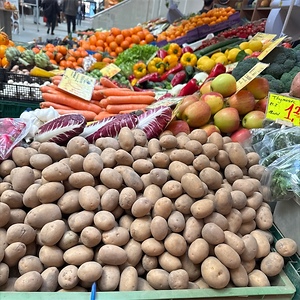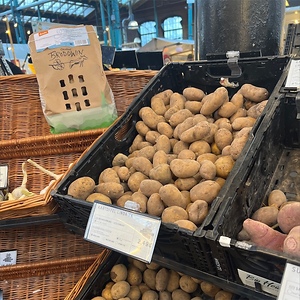


Linda Potatoes
Estimated Inventory, lb : 0
Description/Taste
Linda potatoes are a medium to large varietal, averaging 7 to 10 centimeters in length and 5 to 6 centimeters in diameter, and have a uniform, elongated, and oval appearance. The tuber's skin is semi-thin, smooth, golden yellow, and taut, covered in a few shallow, flat eyes. In fresh markets, Linda potatoes are often sold with a layer of soil on the surface, giving the tubers a brown coloring. Underneath the surface, the golden yellow flesh is dense, moist, and slippery when raw. Once the waxy flesh is cooked, it develops a fine-grained, smooth, and firm but tender consistency. The flesh also holds its shape well. Linda potatoes have a mild, buttery, earthy, and subtly sweet flavor.
Seasons/Availability
Linda potatoes are available year-round.
Current Facts
Linda potatoes, botanically classified as Solanum tuberosum, are a German variety belonging to the Solanaceae family. The yellow potatoes are a medium early maturing cultivar developed in the mid-20th century as a maincrop commercial variety. After their release, Linda potatoes were favored by growers for their high yields, firm nature, and ability to be harvested in 130 to 150 days after sowing. The variety remained a stable cultivar throughout Germany for thirty years, but despite its popularity among consumers, in the early 21st century, Linda potatoes almost became extinct from commercial markets. For several tumultuous years, the fate of Linda potatoes was unknown, but through the efforts of potato advocates, the variety survived and is still being sold as a commercial cultivar. In the present day, Linda potatoes are a festkochend, translating from German to mean waxy variety, and are primarily utilized in cooked applications where the potato's firm nature and ability to hold its shape is showcased.
Nutritional Value
Linda potatoes, like other yellow varieties, are a source of vitamin C to strengthen the immune system while reducing inflammation, iron to make the protein hemoglobin for oxygen transport through the bloodstream, and calcium to build strong bones and teeth. The potatoes also provide potassium to balance fluid levels within the body, vitamin B6 to produce red blood cells, folate to develop RNA and DNA, and fiber to regulate the digestive tract.
Applications
Linda potatoes have a buttery, subtly sweet flavor suited for cooked preparations. The variety is considered an all-purpose potato with a slightly waxy consistency. Linda potatoes are favored for cubing and tossing into soups, stews, and curries, boiling whole as a simple side dish, or slicing and baking in gratins. The potatoes can also be incorporated into shepherd's pie, cooked into casseroles, baked whole, or cut and fried into small pieces. In Germany, Linda potatoes are traditionally cooked and added to potato salads with celery, eggs, mustard, fresh herbs, and mayonnaise. The variety is said to have a smooth but firm texture, giving the salads enough consistency as a substantial side dish. Linda potatoes are also used in German fried potatoes, a popular accompaniment to sausages, meatloaf, or other hearty meats. One of the distinct characteristics of Linda potatoes is their transition in consistency from waxy to floury if kept in storage for too long. If the variety becomes floury, it is typically made into German potato dumplings or added to fried potato pancakes. Linda potatoes pair well with herbs such as chives, parsley, scallions, and rosemary, aromatics including garlic, ginger, and shallots, meats such as beef, pork, and turkey, and vegetables such as celery, carrots, cabbage, and apples. Whole, unwashed Linda potatoes will keep for several weeks when stored in a cool, dry, and dark location, but it is best to consume within 1 to 2 weeks for the best quality and flavor.
Ethnic/Cultural Info
Linda potatoes are more than just a commercial variety for Karsten Ellenberg, an organic farmer and preservationist in Lower Saxony, northwestern Germany. Ellenberg's farm has been passed between familial generations for over five centuries, and during Ellenberg's time as its owner, more than half of the potatoes grown on the farm have been Linda. When Europlant decided to remove Linda potatoes from the market in 2004, Ellenberg rebelled against the decree and spearheaded the campaign to save the variety. To Ellenberg, Linda potatoes were a symbol of the power of the common people. He detested a company's ability to control a market, disregarding public demand, and used the public's voice to fight against this power. Ellenberg initially protested the announcement by planting all the Linda seeding potatoes he normally sells to perpetuate the discontinued variety. Europlant eventually heard of his seeded protest and sought legal assistance, forcing over two hundred and fifty tons of Linda potatoes to be confiscated. After his initial plan was foiled, Ellenberg shifted gears and collaborated with several organizations and groups to launch a public relations campaign on Linda potatoes with the memorable cry of "rettet Linda," translating to "save Linda!" At one point, media outlets were commenting on the potato, a rock band in Bremen, Germany, changed their name to Linda Potatoes in 1993 out of love for the spud, and the federal minister of consumer affairs even praised the grassroots effort to save the "Queen of the potatoes." Ellenberg's efforts eventually paid off, but his work fighting for Linda potatoes had just begun. Beside his potato fields, Ellenberg also has a homemade laboratory where he has been collecting and preserving potato varieties. Ellenberg has hundreds of varieties preserved in his workspace, and multiple sprouts and samples of Linda potatoes have been maintained to protect the variety from extinction.
Geography/History
Linda potatoes were developed by Friedrich Böhm of Saatzucht Böhm, translating to Böhm Seed Cultivation, in Trauen, Germany, in 1964. The variety was bred from a cross between Hansa and Clivia potatoes. Ten years after their creation in 1974, Linda potatoes became an official variety recognized by the German Federal Plant Variety Office and were granted protection of the variety to be sold commercially. Linda potatoes saw initial success in northern Germany, and in the 1990s, Saatzucht Böhm eventually merged with other North German cultivation companies to become Europlant Pflanzenzucht GmbH. In 2004, after the variety's 30-year license had expired, Europlant decided to remove Linda potatoes from commercial production and instead introduce a more disease-resistant variety known as Belana. This decision forced any grower within Germany who produced Linda potatoes to cease plantings, and many potato farmers became disgruntled at the lack of control. A movement was launched by potato farmer Karsten Ellenberg in 2004 to save Linda potatoes from disappearing. A group of growers, potato advocates, and agricultural organizations joined Ellenberg in the fight to save Laura potatoes under the collective name "Freundeskreis Rettet Linda" or "circle of friends save Linda." In 2005, Ellenberg applied for the variety to be reapproved. The Federal Plant Variety Office extended its reapproval decision for another two years, allowing Linda potatoes to be grown during this time. In 2007, Linda potatoes were named "Potato of the Year" from a collaboration between several agricultural associations, further attracting public attention and demand. In 2009, Ellenberg flew to England and received approval from the British Plant Variety Protection Office for Linda as a registered variety in the United Kingdom. This new registration led to Linda potatoes being reapproved by the Federal Plant Variety Office in 2010 for cultivation in Germany. Today Linda potatoes are grown throughout Europe, including Denmark, the United Kingdom, Germany, and Scotland, and are sold as a specialty variety in local markets and select grocers.









